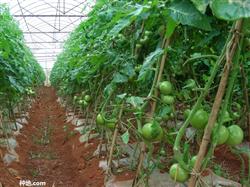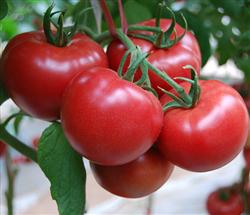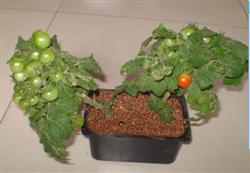How to plant hybrid tomato

How do hybrid tomatoes grow? Please introduce hybrid tomatoes can refer to the following planting techniques: First, cultivating strong seedlings is the premise of high seed yield. 1. Seedbed preparation can be used according to local characteristics. Such as hotbeds, cold beds, greenhouses, plastic greenhouses or electric hotbeds, etc. Because the foreign parents seed is few, for the sake of safety, it is best to sow in greenhouse bed. In order to better control the temperature in the seedbed, it is best to transfer the seedbed with a cold bed. The cold bed consists of cold-proof articles, polypropylene rope, new plastic film, bamboo chips and bed soil. The cooling bed specification is 1.8 meters wide, and the length can be determined according to the seedling area, and the minimum length shall not be less than 2 meters. The minimum length of female parent transfer seedbed shall not be less than 2.5 meters. Bed soil is composed of sifted disease-free field soil, decomposed manure and decomposed horse manure, which are evenly mixed according to the ratio of 5:3:2. The thickness is 20 cm, and the bed surface is 10 cm deep from the ground. 2. Seed soaking, germination and sowing of male parent are 10~12 days earlier than female parent. First put the parent seeds in water at about 25℃ to wash off the drug coat, and then soak for 8~12 hours, subject to soaking thoroughly. Soaked seeds are wrapped in a wrung wet towel and placed in a container. Put the container on the kang at 28~30℃ for germination, and sprout in 2~3 days. During germination, the seeds were washed with warm water of 25~30℃ once a day in the morning and evening, and attention was paid to turning the seeds frequently to make the temperature uniform and sprout neatly. When about 80% of seeds sprout, bud length does not exceed 2 mm should be sown immediately. Sow seeds at 12 noon on a sunny day with uniform soil thickness. Then, stir fried bean cake and carbofuran in a ratio of 50:1, apply 50g per square meter of seedbed to control underground pests, and then cover the bed surface with plastic film to preserve moisture. When the seedlings emerge, remove the plastic film and keep the temperature in the bed at 15℃ during the day and 8~10℃ at night by airing, and stop airing after two days to keep the temperature at 25~30℃ during the day and 15℃ at night. 3. Transplantation and management When the seedlings grow 4 leaves, start transplanting, seedling spacing 8~10 cm ×8~10 cm. 5 days before transplanting seedlings, the seedbed shall be well prepared, grooves 5 cm deep shall be dug on the bed surface according to the seedling spacing, seedlings shall be placed, and then watering shall be carried out in the grooves, and the water shall be used for covering the grooves after infiltration. After seedling slowing, remove the film in the morning according to the soil condition, irrigate the bed soil 10 cm deep with a watering can, and then seal the film tightly to increase the temperature of the bed soil, so that the temperature in the bed reaches 28~30℃ in the daytime and 15~18℃ at night. If the temperature in the bed exceeds 30℃ after the bacteria transfer and before the seedlings are slowed down, use straw curtains or other shade objects to shade the flowers on the shed film to cool down, so as to avoid being too tightly covered and opaque. After seedling slowing down, the temperature in the bed should be controlled to meet the needs of moisture, and the temperature must be controlled by air release. Vents should be set on both sides of the seedbed, staggered arrangement and often change position, vent with the temperature rise to gradually increase, 5 days before planting gradually remove all shed film, seedling training, to adapt to the open field environment. Before planting, root irrigation with 50% thiram 500 times solution, 2~3 kg/m2, and spraying with 75% chlorothalonil. 2. Location 1. Selection of plots and arrangement of crop rotation: sandy loam, loam or clay loam with convenient irrigation, good drainage, deep soil layer and rich organic matter shall be selected as farming land, and rotation with other crops except Solanaceae shall be carried out for 3~5 years. The female parents of different varieties can be planted adjacent to each other, and there should be an isolation area of more than 30 meters between the male parent of one variety and the female parent of another variety. 2. Soil preparation, bed preparation and base fertilizer application: autumn ploughing is carried out on the selected land in the autumn of the first year, the depth is more than 30 cm, the land is leveled in the spring of the next year, and the bed is tilled in time. Both parents were cultivated with high ridge plastic film. The height of the ridge is 10 cm, the width of the male parent ridge is 1 m, the width of the female parent ridge is 1.2 m, and the length of the father and female parent ridge is 10~15 m. The ridge with flat land and uniform water supply can be slightly longer, otherwise it should be shorter. 75kg calcium superphosphate and 1500kg decomposed chicken manure are mixed evenly with each mu, mixed into 5000kg decomposed farm manure, applied into the middle furrow of the ridge as base fertilizer, leveled immediately after rain or irrigation when the soil is not sticky, and covered with 90cm wide plastic film. 3. After the late frost, planting in the afternoon, first planting male parent, then planting female parent. When planting, punch holes according to plant and row spacing (both 40cm), put more than 10 grains of diammonium phosphate at the bottom of planting holes, plant seedlings with soil lumps into holes, pour water into holes twice, and seal planting holes with dry soil after water infiltration. 4. After planting, immediately insert and tie the vine to the parent and female parent to prevent the wind from blowing off the seedlings. The male parent is inserted into a single stick frame with a bamboo pole 60 cm long, and the female parent is used!~ 1.2 Meter-long bamboo poles inserted into the human character frame. The frame should be inserted 10 cm from the root of the outside of the bed. 5. Pruning and branching male parents do not shoot branches, female parents when the branches grow to about 3.3 cm long, to be promptly broken off. The female parent adopts three-branch pruning method. When the female vine has more than three inflorescences, the child vine closest to the inflorescence under the first and second inflorescences of the female vine is selected and the rest child vines are broken off. When two inflorescences of female vine are capped, a grandvine is left on the first vine and under the first inflorescence closest to the first inflorescence, and the grandvine and the second vine form three stems, except for the case of capping more than three inflorescences. When a female vine inflorescence is capped, the female vine is replaced by the child vine closest to the inflorescence under the first inflorescence of the female vine, and the rest of the child vines are broken off, and a grandson vine is respectively reserved under the first and second inflorescences of the child vine to form three stems. Click for more tomato growing techniques Click for more vegetable growing techniques
- Prev

What about the dormancy of tomato seeds?
What about the dormancy of tomato seeds? Please guide seed dormancy is the phenomenon that viable seeds cannot germinate under suitable environmental conditions due to internal reasons. Effectively breaking dormancy is a very important problem in production, which has a direct impact on Miaoqi and Miaozhuang. We summed up the break of tomato seeds.
- Next

How to grow tomatoes on the balcony?
How to grow tomatoes on the balcony? Please guide the balcony to plant tomatoes can refer to the following methods: soak tomato seeds in warm water for 20 minutes, and constantly stir, take out and soak in clean water for about 4 minutes for 5 hours, the amount of water is more than 5 times that of seeds. Then wrap it in a wet cloth and put it at 28-30 ℃ for budding.
Related
- Where is it suitable to grow horseradish in China? it is expected to see the middle altitude horseradish in Alishan.
- How to prevent tomato virus disease reasonably? (Control methods included)
- Many people like to plant towel gourd on the balcony. What are the main points of this method and management?
- What crops can chili peppers be mixed with?
- Fertilization techniques and matters needing attention in Tomato
- What are the grafting techniques for peach seedlings in spring?
- Harm and control methods of root swelling disease of Chinese cabbage
- What are the pests of sweet potatoes? How to prevent and cure it?
- Symptoms, causes and Control methods of navel Rot in Tomato
- The cause of "Cucumber rotten bibcock" in Farmers' planting Cucumber and its Control Plan

